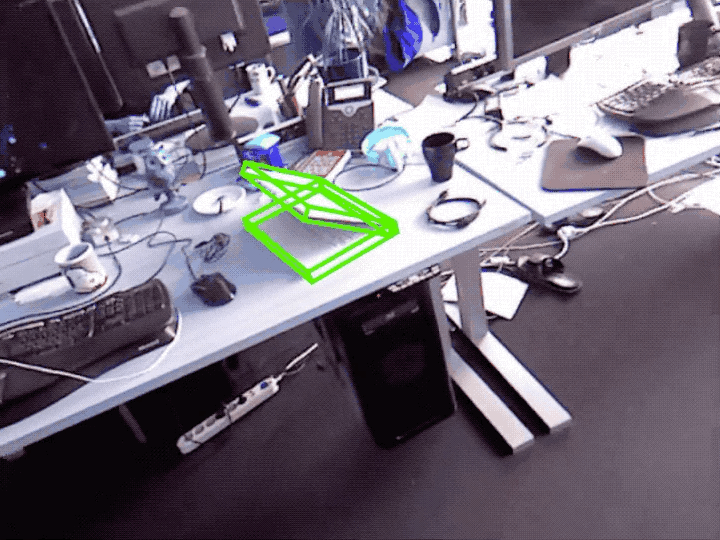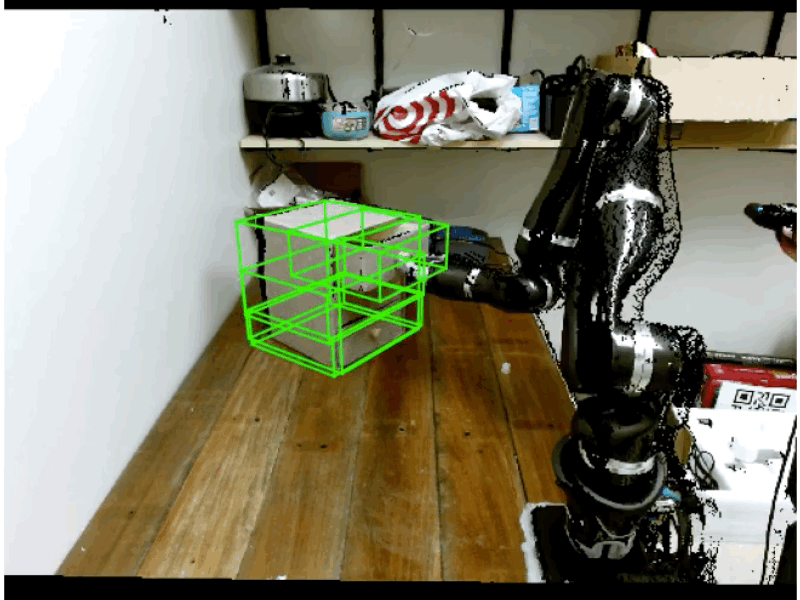CAPTRA: CAtegory-level Pose Tracking for Rigid and Articulated Objects from Point Clouds
Introduction
This is the official PyTorch implementation of our paper CAPTRA: CAtegory-level Pose Tracking for Rigid and Articulated Objects from Point Clouds. This repository is still under construction.
For more information, please visit our project page.
Result visualization on real data. Our models, trained on synthetic data only, can directly generalize to real data, assuming the availability of object masks but not part masks. Left: results on a laptop trajectory from BMVC dataset. Right: results on a real drawers trajectory we captured, where a Kinova Jaco2 arm pulls out the top drawer.
Citation
If you find our work useful in your research, please consider citing:
@article{weng2021captra,
title={CAPTRA: CAtegory-level Pose Tracking for Rigid and Articulated Objects from Point Clouds},
author={Weng, Yijia and Wang, He and Zhou, Qiang and Qin, Yuzhe and Duan, Yueqi and Fan, Qingnan and Chen, Baoquan and Su, Hao and Guibas, Leonidas J},
journal={arXiv preprint arXiv:2104.03437},
year={2021}
Updates
- [2021/04/14] Released code, data, and pretrained models for testing & evaluation.
- [2021/04/22] Released code and data for training.
Installation
-
Our code has been tested with
- Ubuntu 16.04, 20.04, and macOS(CPU only)
- CUDA 11.0
- Python 3.7.7
- PyTorch 1.6.0
-
We recommend using Anaconda to create an environment named
captradedicated to this repository, by running the following:conda env create -n captra python=3.7 conda activate captra
-
Create a directory for code, data, and experiment checkpoints.
mkdir captra && cd captra
-
Clone the repository
git clone https://github.com/HalfSummer11/CAPTRA.git cd CAPTRA -
Install dependencies.
pip install -r requirements.txt
-
Compile the CUDA code for PointNet++ backbone.
cd network/models/pointnet_lib python setup.py install
Datasets
-
Create a directory for all datasets under
captramkdir data && cd data
- Make sure to point
basepathinCAPTRA/configs/obj_config/obj_info_*.ymlto your dataset if you put it at a different location.
- Make sure to point
NOCS-REAL275
mkdir nocs_data && cd nocs_dataTest
-
Download and unzip nocs_model_corners.tar, where the 3D bounding boxes of normalized object models are saved.
wget http://download.cs.stanford.edu/orion/captra/nocs_model_corners.tar tar -xzvf nocs_real_corners.tar
-
Create
nocs_fullto hold original NOCS data. Download and unzip "Real Dataset - Test" from the original NOCS dataset, which contains 6 real test trajectories.mkdir nocs_full && cd nocs_full wget http://download.cs.stanford.edu/orion/nocs/real_test.zip unzip real_test.zip
-
Generate and run the pre-processing script
cd CAPTRA/datasets/nocs_data/preproc_nocs # generate the script for data preprocessing # parallel & num_proc specifies the number of parallel processes in the following procedure python generate_all.py --data_path ../../../../data/nocs_data --data_type=test_only \ --parallel --num_proc=10 > nocs_preproc.sh # the actual data preprocessing bash nocs_preproc.sh
-
After the steps above, the folder should look like File Structure - Dataset Folder Structure.
Train
-
Download and unzip "CAMERA Dataset - Training/Test" and "Real Dataset - Training" from the original NOCS dataset under
nocs_data/nocs_full# current path relative to project root (captra): data/nocs_data/nocs_full wget http://download.cs.stanford.edu/orion/nocs/camera_train.zip unzip camera_train.zip wget http://download.cs.stanford.edu/orion/nocs/camera_val25K.zip unzip camera_val25K.zip wget http://download.cs.stanford.edu/orion/nocs/real_train.zip unzip real_train.zip-
By now,
nocs_fullshould be structured as follows. Note that the depth image (*_depth.png) only contains the synthetic foreground objects. For our purpose, we need a complete depth image composing both the synthetic foreground and the real background.nocs_full ├── real_test ├── real_train ├── train │ ├── 00000 │ │ ├── 0000_color.png, 0000_coord.png, 0000_depth.png, 0000_mask.png, 0000_meta.txt │ │ ├── 0001_color.png, ... │ │ └── ... │ ├── 00001 │ └── ... └── val # same structure as train
-
-
Download and unzip "CAMERA Dataset - Composed_depths" from the original NOCS dataset under
nocs_data.cd ../ # current path relative to project root (captra): data/nocs_data wget http://download.cs.stanford.edu/orion/nocs/camera_composed_depth.zip unzip camera_composed_depth.zip
This will result in a folder named
camera_full_depths, structured as follows.camera_full_depths ├── train │ ├── 00000 │ │ ├── 0000_composed.png # depth image containing both synthetic foreground objects │ │ │ # and the real background │ │ ├── 0001_composed.png # rendered object normalized coordinates │ │ └── ... │ ├── 00001 │ └── ... └── val # same structure as train
Then copy-merge
camera_full_depthswithnocs_full.# merge camera_full_depth/train/????? to nocs_full/train/????? rsync -arv camera_full_depths/ nocs_full/ rm -r camera_full_depths -
Generate and run the pre-processing script
cd CAPTRA/datasets/nocs_data/preproc_nocs python generate_all.py --data_path ../../../../data/nocs_data --data_type=all --parallel --num_proc=10 > nocs_preproc_all.sh # generate the script for data preprocessing # parallel & num_proc specifies the number of parallel processes in the following procedure bash nocs_preproc_all.sh # the actual data preprocessing
-
After the steps above, the folder should look like [File Structure - Dataset Folder Structure](#File Structure).
SAPIEN Synthetic Articulated Object Dataset
mkdir sapien_data && cd sapien_dataTest
-
Download and unzip object URDF models and testing trajectories
wget http://download.cs.stanford.edu/orion/captra/sapien_urdf.tar wget http://download.cs.stanford.edu/orion/captra/sapien_test.tar tar -xzvf sapien_urdf.tar # urdf tar -xzvf sapien_test.tar # render_seq
Train
-
Download and unzip training data.
wget http://download.cs.stanford.edu/orion/captra/sapien_train.tar tar -xzvf sapien_train.tar # render
Testing & Evaluation
Download Pretrained Model Checkpoints
-
Create a folder
runsundercaptrafor experimentsmkdir runs && cd runs
-
Download our pretrained model checkpoints for
- NOCS-REAL275: nocs_ckpt.tar
- SAPIEN synthetic articulated object dataset: sapien_ckpt.tar
-
Unzip them in
runstar -xzvf nocs_ckpt.tar
which should give
runs ├── 1_bottle_rot # RotationNet for the bottle category ├── 1_bottle_coord # CoordinateNet for the bottle category ├── 2_bowl_rot └── ...
Testing
-
To generate pose predictions for a certain category, run the corresponding script in
CAPTRA/scripts/track(without further specification, all scripts are run fromCAPTRA), e.g. for the bottle category from NOCS-REAL275,bash scripts/track/nocs/1_bottle.sh
-
The predicted pose will be saved under the experiment folder
1_bottle_rot(see File Structure - Experiment Folder Structure). -
To test the tracking speed for articulated objects in SAPIEN, make sure to set
--batch_size=1in the script. You may use--dataset_length=500to avoid running through the whole test set.
Evaluation
-
To evaluate the pose predictions produced in the previous step, uncomment and run the corresponding line in
CAPTRA/scripts/eval.sh, e.g. for the bottle category from NOCS-REAL275, the corresponding line ispython misc/eval/eval.py --config config_track.yml --obj_config obj_info_nocs.yml --obj_category=1 --experiment_dir=../runs/1_bottle_rot
Training
-
To train the CoordinateNet and RotationNet for a certain category, run the corresponding script in
CAPTRA/scripts/train, e.g. for the bottle category from NOCS-REAL275, scripts can be found inCAPTRA/scripts/train/nocs/1_bottle.sh.# RotationNet python network/train.py --config=config_rotnet.yml --obj_config=obj_info_nocs.yml \ --pose_perturb/r=5.0 --pose_perturb/t=0.03 --pose_perturb/s=0.02 \ --batch_size=12 \ --obj_category=1 \ --experiment_dir=../runs/1_bottle_rot_new \ --use_val=real_test \ --num_workers=2 # CoordinateNet python network/train.py --config=config_coordnet.yml --obj_config=obj_info_nocs.yml \ --pose_perturb/r=5.0 --pose_perturb/t=0.03 --pose_perturb/s=0.02 \ --batch_size=12 \ --obj_category=1 \ --experiment_dir=../runs/1_bottle_coord_new \ --use_val=real_test \ --num_workers=2
-
The output logs and checkpoints will be saved at
1_bottle_rot_new/log,1_bottle_rot_new/ckpt, respectively. (see [File Structure - Experiment Folder Structure](#File Structure)). -
For NOCS dataset, after training the models using synthetic data, we can further finetune them with real training data. To do this, simply replace
train.pywithtrain_nocs_finetune.pyin the training script. Use--syn_nand--real_onlyto adjust the proportion of real/synthetic training data used in each epoch.
File Structure
Overall Structure
The working directory should be organized as follows.
captra
├── CAPTRA # this repository
├── data # datasets
│ ├── nocs_data # NOCS-REAL275
│ └── sapien_data # synthetic dataset of articulated objects from SAPIEN
└── runs # folders for individual experiments
├── 1_bottle_coord
├── 1_bottle_rot
└── ...Code Structure
See here for an overview of our code. Only the most relevant folders/files are shown.
CAPTRA
├── configs # configuration files
│ ├── all_config # experiment configs
│ ├── pointnet_config # pointnet++ configs (radius, etc)
│ ├── obj_config # dataset configs
│ └── config.py # parser
├── datasets # data preprocessing & dataset definitions
│ ├── arti_data # articulated data
│ │ └── ...
│ ├── nocs_data # NOCS-REAL275 data
│ │ ├── ...
│ │ └── preproc_nocs # prepare nocs data
│ └── ... # utility functions
├── pose_utils # utility functions for pose/bounding box computation
├── utils.py
├── misc # evaluation and visualization
│ ├── eval
│ └── visualize
├── scripts # scripts for training/testing
└── network # main part
├── data # torch dataloader definitions
├── models # model definition
│ ├── pointnet_lib
│ ├── pointnet_utils.py
│ ├── backbones.py
│ ├── blocks.py # the above defines backbone/building blocks
│ ├── loss.py
│ ├── networks.py # defines CoordinateNet and RotationNet
│ └── model.py # defines models for training/tracking
├── trainer.py # training agent
├── parse_args.py # parse arguments for train/test
├── test.py # test
├── train.py # train
└── train_nocs_mix.py # finetune with a mixture of synthetic/real dataExperiment Folder Structure
For each experiment, a dedicated folder in `captra/runs` is created. See here for its organization.
1_bottle_rot
├── log # training/testing log files
│ └── log.txt
├── ckpt # model checkpoints
│ ├── model_0001.pt
│ └── ...
└── results
├── data* # per-trajectory raw network outputs
│ ├── bottle_shampoo_norm_scene_4.pkl
│ └── ...
├── err.csv** # per-frame error
└── err.pkl** # per-frame error
*: generated after testing with --save
**: generated after running misc/eval/eval.pyDataset Folder Structure
See here for the organization of dataset folders.
nocs_data
├── nocs_model_corners # instance bounding box information
├── nocs_full # original NOCS data, organized in frames (not object-centric)
│ ├── real_test
│ │ ├── scene_1
│ │ └── ...
│ ├── real_train
│ ├── train # see the following
│ └── val
├── instance_list* # collects each instance's occurences in nocs_full/*/
├── render* # per-instance segmented data for training
├── preproc** # cashed data
└── splits** # data lists for train/test
*: generated after data-preprocessing
**: generated during training/testing
# Specifically, nocs_data/nocs_full/train (and val) should be structured as follows:
train
├── 00000
│ ├── 0000_coord.png # rendered object normalized coordinates
│ ├── 0000_depth.png # depth image containing synthetic foreground objects only
│ ├── 0000_mask.png # object mask
│ ├── 0000_meta.txt # meta information
│ ├── 0000_composed.png* # depth image containing both synthetic foreground objects
│ │ # and the real background
│ ├── 0000_pose.pkl** # object poses computed from *_coord.png and *_depth.png
│ └── ...
├── 00001
└── ...
*: generated after copy-merging camera_full_depths with nocs_full
**: generated after data-preprocessing
sapien_data
├── urdf # instance URDF models
├── render_seq # testing trajectories
├── render** # single-frame training/validation data
├── preproc_seq* # cashed testing trajectory data
├── preproc** # cashed testing trajectory data
└── splits* # data lists for train/test
*: generated during training/testing
**: trainingAcknowledgements
This implementation is based on the following repositories. We thank the authors for open sourcing their great works!


